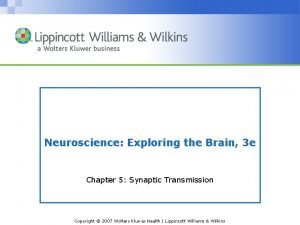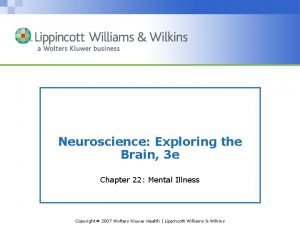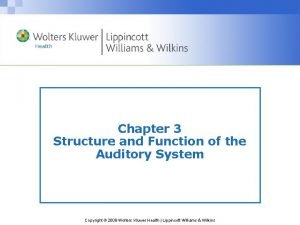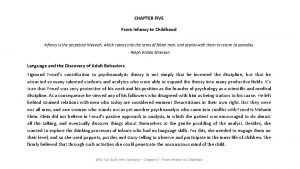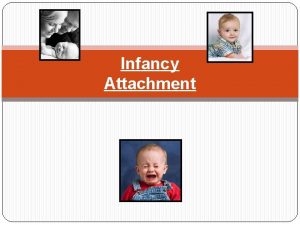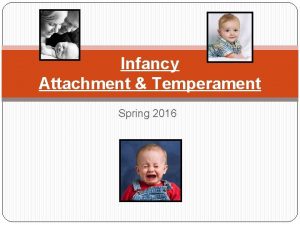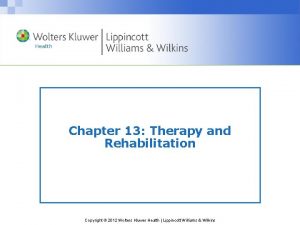Chapter 10 Infancy and Childhood Copyright 2012 Wolters































- Slides: 31

Chapter 10 Infancy and Childhood Copyright © 2012 Wolters Kluwer Health | Lippincott Williams & Wilkins

Human Growth and Development • Growth – Change in body size and structure • Development – Change in body function • Genetic Factors – Hereditary characteristics inherited from parents • Regression – A child’s behavior may go backward to that of an earlier stage of development. Copyright © 2012 Wolters Kluwer Health | Lippincott Williams & Wilkins

Human Growth and Development (cont’d) • The process of growth and development has the following characteristics: – Orderly sequence – Simple to complex – Cephalocaudal – Inclusive – Proximodistal – Interdependent Copyright © 2012 Wolters Kluwer Health | Lippincott Williams & Wilkins

Principles of Growth and Development Copyright © 2012 Wolters Kluwer Health | Lippincott Williams & Wilkins

Erikson: Psychosocial Development • Focuses on the psychosocial and environmental aspects of personality as the person progresses from birth to death. • Every stage of development contains: – Psychosocial challenge – Influence of a significant person or group – Necessary accomplishment – Appropriate virtues – Ways to help the child succeed Copyright © 2012 Wolters Kluwer Health | Lippincott Williams & Wilkins

Question According to Erikson, a good way to help toddlers succeed is by: a. Satisfying their basic needs b. Managing sibling rivalry c. Giving responsibility d. Encouraging curiosity e. Explaining things Copyright © 2012 Wolters Kluwer Health | Lippincott Williams & Wilkins

Answer d. Encouraging curiosity Encouraging toddlers’ instinctive curiosity, while setting limits, carries them to new fields to conquer and encourages growth and development. Copyright © 2012 Wolters Kluwer Health | Lippincott Williams & Wilkins

Piaget: Cognitive Development • Cognitive – Knowledge, understanding, or perception • Four major levels of cognitive development: – Sensorimotor – Preoperational – Concrete operations • Exhibits reversibility, seriation, and conservation of matter. – Formal operations Copyright © 2012 Wolters Kluwer Health | Lippincott Williams & Wilkins

Question Is the following statement true or false? According to Piaget, toddlers begin to understand quantities, weight, and volume. Copyright © 2012 Wolters Kluwer Health | Lippincott Williams & Wilkins

Answer False According to Piaget, children between the ages of 7 and 11 begin to understand quantities, weight, and volume. They recognize that 8 ounces of juice is the same amount whether it is in a can or a glass. Toddlers develop an understanding of object permanence. Copyright © 2012 Wolters Kluwer Health | Lippincott Williams & Wilkins

Role of Play in Childhood Development • Play with other children encourages peer cooperation, interaction, and sharing. • Play enhances fine and large muscle coordination and strengthens muscles. – Solitary play – Parallel play Copyright © 2012 Wolters Kluwer Health | Lippincott Williams & Wilkins

Anticipatory Guidance for Caregivers • Concern – Behavioral and developmental issues • The nurse should – Communicate that normal growth and development occur within a wide range – Help caregivers understand the needs and problems of children – Help caregivers and children work toward increased abilities, skills, self-knowledge, and self-discipline Copyright © 2012 Wolters Kluwer Health | Lippincott Williams & Wilkins

Growth and Development of Infants • Infancy – The period from 1 to 12 months of age. • Physical growth by the end of the year – Weigh about three times their birth weight – Increase birth height by about half – Have six to eight deciduous teeth Copyright © 2012 Wolters Kluwer Health | Lippincott Williams & Wilkins

Growth and Development of Infants (cont’d) • Psychosocial Development – Establishment of trust in primary caregivers – Changing families and role of caregivers – Bonding – Accomplishing tasks • Cognitive and Motor Development – Depends on physical maturity and environmental factors Copyright © 2012 Wolters Kluwer Health | Lippincott Williams & Wilkins

Growth and Development of Infants (cont’d) • Cognitive and Motor Development – Stranger anxiety • Temperament • Past experiences with strangers • New environments • Presence of primary caregiver, number of caregivers • Interaction of strangers • Age Copyright © 2012 Wolters Kluwer Health | Lippincott Williams & Wilkins

Areas of Concern • Feedings • Bottle mouth • Weaning • Sucking • Daycare Copyright © 2012 Wolters Kluwer Health | Lippincott Williams & Wilkins

Growth and Development of Toddlers • Toddler Phase – Encompasses ages 1 to 3 years • Physical Growth – Gain only about 4 pounds annually – Grow about 2 to 3 inches per year – Make great strides in physical and motor skills Copyright © 2012 Wolters Kluwer Health | Lippincott Williams & Wilkins

Growth and Development of Toddlers (cont’d) • Psychosocial Development – Challenge • Autonomy (independence) versus shame and doubt – Virtues • Self-control and willpower • Discipline Copyright © 2012 Wolters Kluwer Health | Lippincott Williams & Wilkins

Growth and Development of Toddlers (cont’d) • Cognitive and Motor Development – Intellectual and social development – Increased motor skills – Verbal skills improve Copyright © 2012 Wolters Kluwer Health | Lippincott Williams & Wilkins

Areas of Concern • Toilet training • Accident prevention • Setting limits • Thumb sucking and the security blanket • Temper tantrums • Sleep habits and the family bed • Separation anxiety Copyright © 2012 Wolters Kluwer Health | Lippincott Williams & Wilkins

Growth and Development of Preschoolers • Preschool Phase – Encompasses ages 3 to 6 years – Physical growth • May gain less than 6 lb per year • May gain 3 inches annually until school • Have a steadier walk Copyright © 2012 Wolters Kluwer Health | Lippincott Williams & Wilkins

Growth and Development of Preschoolers (cont’d) • Psychosocial Development – Challenge • To acquire initiative – Virtue • Sense of direction and purpose Copyright © 2012 Wolters Kluwer Health | Lippincott Williams & Wilkins

Growth and Development of Preschoolers (cont’d) • Cognitive and Motor Development – Develop more refined motor skills become by age 3 years – Have great desire to be independent and to do things on their own – Comfortable with themselves and their relationships with others by age 5 years Copyright © 2012 Wolters Kluwer Health | Lippincott Williams & Wilkins

Areas of Concern • Sibling rivalry • Phobias and nightmares • Masturbation • Enuresis Copyright © 2012 Wolters Kluwer Health | Lippincott Williams & Wilkins

Growth and Development of School-Aged Children • School-Age – Encompasses ages 6 to 10 years • Physical Growth – Slow and steady period of growth begins – Lose deciduous teeth – Permanent teeth erupts Copyright © 2012 Wolters Kluwer Health | Lippincott Williams & Wilkins

Growth and Development of School-Aged Children (cont’d) • Psychosocial Development – Challenge • Developing a sense of industry – Virtues • Sense of belonging • Feelings of competence and self-worth Copyright © 2012 Wolters Kluwer Health | Lippincott Williams & Wilkins

Growth and Development of School-Aged Children (cont’d) • Cognitive and Motor Development – Become increasingly independent – Fitting in becomes very important – Learn to abide by rules – Reasoning and conceptual powers expand Copyright © 2012 Wolters Kluwer Health | Lippincott Williams & Wilkins

Areas of Concern • Sibling rivalry • Responsibilities • Sex education Copyright © 2012 Wolters Kluwer Health | Lippincott Williams & Wilkins

Question Is the following statement true or false? Toddlers who throw tantrums during their “terrible twos” are doing so out of frustration and not to deliberately misbehave. Copyright © 2012 Wolters Kluwer Health | Lippincott Williams & Wilkins

Answer False Tantrums are outbursts of anger and frustration. They usually result from feelings of frustration at being unable to express feelings and at a lack of control over day-to-day decisions. Tantrums are more common when children are hungry, tired, frustrated, or feeling neglected. Copyright © 2012 Wolters Kluwer Health | Lippincott Williams & Wilkins

End of Presentation Copyright © 2012 Wolters Kluwer Health | Lippincott Williams & Wilkins
 Early childhood
Early childhood Psychology chapter 10 infancy and childhood
Psychology chapter 10 infancy and childhood Psychology chapter 10 infancy and childhood
Psychology chapter 10 infancy and childhood Chapter 10 infancy and childhood review worksheet answers
Chapter 10 infancy and childhood review worksheet answers Social development in infancy and childhood
Social development in infancy and childhood Module 47 infancy and childhood cognitive development
Module 47 infancy and childhood cognitive development Infancy and childhood psychology
Infancy and childhood psychology Internally programmed growth of a child
Internally programmed growth of a child Lesson quiz 3-2 infancy and childhood
Lesson quiz 3-2 infancy and childhood Rovee-collier
Rovee-collier Module 47 infancy and childhood cognitive development
Module 47 infancy and childhood cognitive development Infancy childhood adolescence adulthood old age
Infancy childhood adolescence adulthood old age Chapter 5 cognitive development in infancy and toddlerhood
Chapter 5 cognitive development in infancy and toddlerhood Dentist copyright 2012
Dentist copyright 2012 Copyright 2012
Copyright 2012 Copyright 2012
Copyright 2012 Copyright 2012
Copyright 2012 Wolters kluwer health
Wolters kluwer health Lippincott
Lippincott Wolters kluwer
Wolters kluwer Wolters kluwer
Wolters kluwer Shunting inhibition
Shunting inhibition Wolters kluwer health
Wolters kluwer health Wolters kluwer health
Wolters kluwer health Wolters kluwer
Wolters kluwer Wolters kluwer
Wolters kluwer Wolters kluwer
Wolters kluwer Wolters kluwer
Wolters kluwer Wolters kluwer
Wolters kluwer Wolters kluwer health
Wolters kluwer health Wolters kluwer
Wolters kluwer Virchows triad
Virchows triad






















